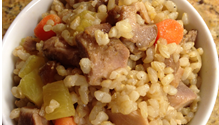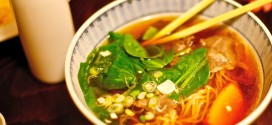By Heidi Zheng
Photo credit to Crane & Turtle
Tucked in a quiet neighborhood of Columbia Heights, Crane & Turtle is star restaurateur Paul Ruppert’s new joint on Georgia Avenue. Unlike his other ventures, such as Petworth Citizen & Reading Room, both of which feature mainly American fares, Crane & Turtle brands itself as French-Japanese fusion, a rarity if not the first of its kind.
“This category is hard to explain; even I have a hard time to specify,” said master chief Makoto Hamamura. Hamamura aims to integrate both French and the Japanese cuisines by choosing cooking techniques from both traditions that best suit the ingredients used, instead of slathering condiments like some Asian-fusion restaurants often do. “French technique, Japanese feeling and Asian flavor, that’s what I’m looking for,” said Hamamura.

The entrance of Crane and Turtle faces directly to an open kitchen that many would associate with a typical sushi bar, where sous chefs are busy pan roasting kohlrabi and julienning fennel, cooking by order on the spot in order to preserve that freshness. The minimally adorned, modern décor gives the place a European vibe, while the piquant aroma of Dandan sauce wafts in the air.

Hamamura was trained in the European style and he doesn’t restrict himself to Japanese cooking. The veteran chef loves Chinese cooking and he recommends his Szechuan Duck, topped with the infamous peppers with a side of Dandan noodles, which he acknowledges as the Chinese predecessor of ramen as we know.

Another one of Hamamura’s signature dishes is the Tataki, raw yellowtail or tuna prepared sashimi-style, then roasted over a hay straw frame on open fire, a method commonly used in the Kochi region where he spent his childhood. Growing up watching his grandparents manage their fish shop, he has an intimate knowledge of this vital ingredient to both cuisines, “I know how to treat fish like no other people.”

Hamamura’s life experience even breathes through the restaurant’s name. According to Washington City Paper, Crane & Turtle is a well-known Japanese fable about the two animals helping each other out through flood and draught, an unlikely synergy that works just as well as the French-Japanese fusion. Interestingly, Crane (“Tsuru”) and Turtle (“Kame”) are also his mother’s and his twin sister’s namesakes, respectively.

In some ways, Crane & Turtle is the odd new kid on the block. Besides Domku, a Scandinavian restaurant across the street that is owned by a Korean American manager, most eateries in the vicinity serve Caribbean comfort food.
But Hamamura is optimistic about growing a following for the restaurant: “My boss chose this neighborhood to help develop [the local community]. This district used to be nothing, just vacancy. People from the city think it’s scary.” With another café opening up in Anacosta, Hamamura and Ruppert hope that their business will draw traffic to these up and coming quarters. For the less ambitious gastronomes, though, if you ever fancy your green tea-flavored macaroons on Japanese chinaware, this is your best bet in town.
 Asian Fortune Your source for all things Asian American
Asian Fortune Your source for all things Asian American



